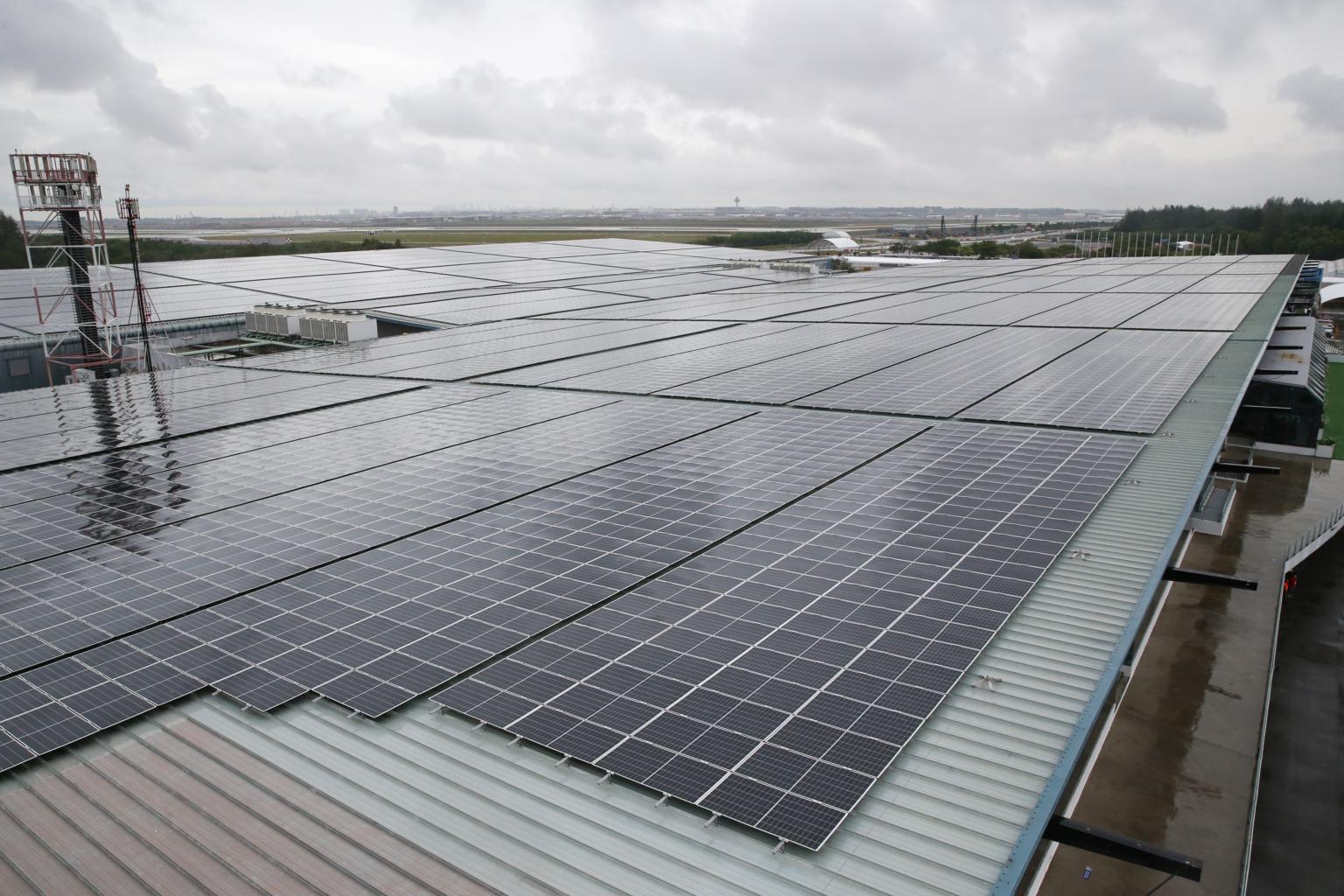Firms in Singapore move to shrink emissions and carbon tax bill with plans for solar, low-carbon tech
Sign up now: Get ST's newsletters delivered to your inbox

Firms are making plans to tap more solar energy and invest in energy-efficiency initiatives or low-carbon research projects.
ST PHOTO: ONG WEE JIN
Follow topic:
SINGAPORE - Large emitters in Singapore that will from 2024 have to pay a higher carbon tax are taking steps to reduce their emissions, with players here making plans to tap more solar energy and invest in energy-efficiency initiatives or low-carbon research projects.
Power-generation firm and electricity retailer PacificLight Power, for instance, told The Straits Times last week that it is developing a 670 megawatt-peak (MWp) solar farm on Bulan Island in Indonesia, which will export electricity to Singapore from 2025. This is enough to power over 144,000 four-room Housing Board flats a year.
To put that in context, the total installed solar capacity in Singapore in the first quarter of 2020 was 350MWp.
"Our solar energy project will play a key role in Singapore's energy transition to a low-carbon future and provide customers with wider access to renewable energy," said a spokesman for PacificLight.
She added that since PacificLight commenced operations in 2013, the firm has improved its plant's efficiency, which helps to reduce emissions.
"We have invested over $5 million in energy-saving initiatives that cut our plant's energy consumption... and reduced carbon emissions by 1.5 per cent," the spokesman said, adding that the firm has plans to upgrade its power plant next year to further reduce its emissions.
Finance Minister Lawrence Wong announced earlier this month that the carbon tax rate will be raised to help Singapore meet its enhanced climate change target of having its emissions dwindle to net-zero by or around 2050, instead of in the second half of the century.
The current rate, which will be in place until next year, is $5 per tonne of emissions. But this will go up to $25 in 2024, $45 in 2026, before reaching $50 to $80 per tonne by 2030.
Singapore's carbon tax applies to all facilities producing 25,000 tonnes or more of greenhouse gas emissions in a year. This covers 30 to 40 large emitters such as oil refineries and power-generation plants, which contribute 80 per cent of Singapore's greenhouse gas emissions.
As a carbon tax assigns costs to the release of such emissions, it can help to level the playing field between pollutive fossil fuels, which have traditionally been cheaper, and low-carbon options such as renewable energy or carbon capture and storage technologies.
A carbon tax can also spur firms to adopt more energy-efficient practices, which can help to reduce emissions and their carbon tax bill.
But how effective such a carbon pricing scheme is in spurring change depends on its quantum.
For instance, the International Energy Agency estimates that the use of carbon capture technologies to take in carbon dioxide from dilute gas streams, such as power generation, could cost between US$40 (S$54) and US$120 for every tonne.
These technologies are still nascent, but with carbon prices going up, they have been attracting more research attention in recent years as they have the potential to take planet-warming gases out of the atmosphere for storage underground.
Oil giants Shell and ExxonMobil told ST they are looking into carbon capture and storage as a way to cut their carbon footprints.
A spokesman for Shell said: "Tackling climate change is an urgent challenge and Shell is acting on it... Shell has halved our crude processing capacity and production of traditional fuels in Singapore."
She also cited other initiatives that Shell has embarked on to reduce its carbon footprint, such as its efforts to set up a large-scale solar farm on Pulau Semakau, expand its electric vehicle charging network, and invest in biofuel production.
Ms Geraldine Chin, chairman and managing director of ExxonMobil Asia Pacific, said that since 2002, the firm has embarked on a series of initiatives that has led to energy efficiency gains of more than 25 per cent, which has helped to reduce carbon dioxide emissions at its Singapore operating facility.
"We have invested US$10 million in the Singapore Energy Centre, which carries out research into lower-carbon energy pathways," she added. "Our team (in Singapore) is working to develop a detailed emissions-reduction road map, as part of the company's ambition to achieve net-zero emissions from its operated assets by 2050."
A spokesman for Keppel - which has a subsidiary that partially owns and operates a power-generation plant on Jurong Island - said it is exploring the import of renewable energy to Singapore from Laos.
The company is also looking into the feasibility of producing green ammonia in Australia for export globally, its spokesman added. Ammonia can be reprocessed to produce hydrogen - a fuel that does not produce carbon dioxide when burned.
A spokesman for the National Climate Change Secretariat said sustainability and global climate action are here to stay.
The carbon tax is aimed at driving long-term behavioural change in support of Singapore's climate ambition, such as getting businesses to take early action to decarbonise and individuals to change consumption habits and behaviour, she said.
"This helps to position Singapore to succeed in a low-carbon world."

